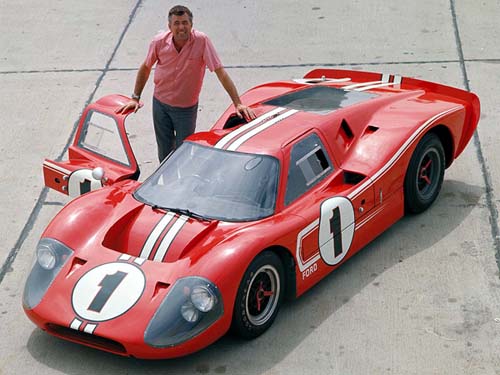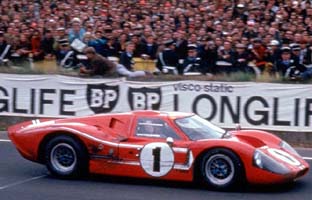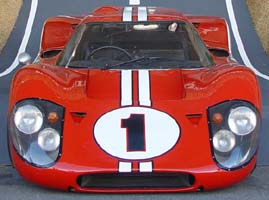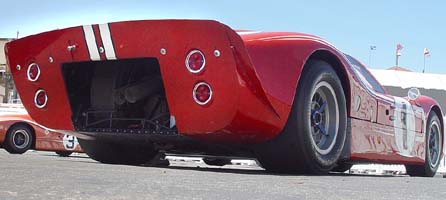US - Ford MK IV (6500) - [1970-71]
-
- 1970
- History
- Intro
- Prototypes
- Cars
- Body
- Windshield
This casting was designed and based on the Ford GT40 Mark IV. The GT40 Mark IV is actually the final evolution of the Ford J-Car.

Carroll Shelby stands with a red 1967 Ford GT MKIV



In 1966, Ford
achieved top honors in the field of international endurance racing. Despite
growing costs, Ford decided to continue development of the GT40 for the 1967
season. This campaign was already the largest and most expensive American
assault on the predominantly European series.
While the 427-powered Mark II
cars proved a
remarkable success in 1966, their hefty weight motivated Roy Lunn, a senior
designer at Ford, to seek out drastically new designs. Two promising
projects had already been in development and both incorporated aluminum in
their chassis design. The first such car was the X1 prototype built by
McLaren Racing Limited. This car featured an aluminum version of the GT40
tub and raced quite successfully, winning at Sebring in 1966. The second
project, called the J car, was a much more experimental than the X1. This
fresh approach appealed to Lunn, who convinced Ford to move forward with the
project.
The J Cars It was the
technique of using honeycomb-sandwiched aluminum which motivated the
J
car.
This technique used half inch honeycomb aluminum
panels which had to be bonded together. The first J car would use this
honeycomb aluminum to form a central tub chassis similar to the GT40's. The
final specification for the car adhered to the Appendix J regulations for
race car construction.
Since Ford Advanced
Vehicles
had been sold off, the J Car was produced by Fords subsidiary Kar Kraft. Ed
Hull headed construction of the experimental J-Car program with assistance
from the Brunswick Aircraft Corporation.
 The first J-car, called J-1, was completed in March of 1966. It's chassis, which
weighed 86 lbs, supported the fiberglass body and 427 engine. J-1 made its
first public appearance at the LeMans trails that year. It weighted 2660 lbs
which was nearly on target with the 300 lb weight reduction Ford was looking
for. At such a weight it was not surprising that the J-Car took the fastest
time at the trials. Unfortunately, the J-Car was sidelined for the rest of
the 1966 season to help the GT40 Mark II's effort.
The first J-car, called J-1, was completed in March of 1966. It's chassis, which
weighed 86 lbs, supported the fiberglass body and 427 engine. J-1 made its
first public appearance at the LeMans trails that year. It weighted 2660 lbs
which was nearly on target with the 300 lb weight reduction Ford was looking
for. At such a weight it was not surprising that the J-Car took the fastest
time at the trials. Unfortunately, the J-Car was sidelined for the rest of
the 1966 season to help the GT40 Mark II's effort.
After the 1966 1-2-3 Le Mans win, Ford decided to invest more money in the
J-Car program. A second car, made up to Can Am specification, was made to
help sort out the aluminum honeycomb chassis. Unfortunately, this car was
completely destroyed during testing in an accident which claimed the life of
Ken Miles. Driver error was never considered.
 After a weak performance at Daytona, where transmission problems plagued six
Mark IIs, Ford reluctantly continued the J-Car program in preparation for
Ferrari's 330 P4. They worked on chassis J-3 and J-4 in preparation for
Sebring.
During this time, Roy Lunn, Chuck Mountain and Phil Remmington worked on the
J-cars extensively. They created a new body for the chassis which
incorporated a longer front nose, a Can Am style tail section and a new roof
line to accept a rear window. During this transformation the J-Cars
officially became known as the GT40 Mark IV.
After a weak performance at Daytona, where transmission problems plagued six
Mark IIs, Ford reluctantly continued the J-Car program in preparation for
Ferrari's 330 P4. They worked on chassis J-3 and J-4 in preparation for
Sebring.
During this time, Roy Lunn, Chuck Mountain and Phil Remmington worked on the
J-cars extensively. They created a new body for the chassis which
incorporated a longer front nose, a Can Am style tail section and a new roof
line to accept a rear window. During this transformation the J-Cars
officially became known as the GT40 Mark IV.
On The Track With the
promising results attained during testing, Ford debuted the Mark IV GT40,
specifically J-4, at Sebring. From the start, J-4 led the race, ahead of Jim
Hall's Chapparal 2F. It took victory with McLaren and Andretti behind the
wheel. After winning on it's debut race, Ford decided to prepare more Mark
IVs for Le Mans, the most important race of the year.
 Of the twelve Fords which appeared for the 1967 Le Mans, four were Mark IVs and
they were divided evenly amongst Holman & Moody and Shelby American. With
Ford facing eight Ferrari Prototypes, including three factory-supported 330
P4s and two Chapparals, the 1967 Le Mans was a great battle.
Of the twelve Fords which appeared for the 1967 Le Mans, four were Mark IVs and
they were divided evenly amongst Holman & Moody and Shelby American. With
Ford facing eight Ferrari Prototypes, including three factory-supported 330
P4s and two Chapparals, the 1967 Le Mans was a great battle.
Throughout the night, each manufacturer had their fair share of retirements.
At 3:30am, Andretti's Mark IV spun on the track and came to rest in the
middle of the track, eventually causing three Ford retirements. Luckily no
drivers were seriously hurt. Through this accident, the red Gurney / Foyt
Mark IV had held the lead, but the lineup was now
Ford-Ferrari-Ferrari-Ferrari-Ford-Porsche.
A Ford Victory. For the
remaining hours, the Gurney / Foyt Mark IV kept the works Ferraris at bay.
Decaled number one, it was Ford's sleek red supercar that took victory at
the 24 Hours of Le Mans.
This remarkable and heavily-reported event appears to have been a good note
for Ford to end their motor sports campaign on. After Le Mans, no Mark IVs
would race again. Ford had beat Ferrari at Le Mans - for the second time -
and that's the story they were after.
Copyright © 2024
www.HWPowered.com
All rights reserved.
The pictures and descriptions on this site may not be reused without obtaining prior permission.
Sizzlers, Chopcycles, Earthshakers & HotLine are a registered Trademarks of Mattel Inc. This site is
not affiliated with Mattel Inc. in any way.
